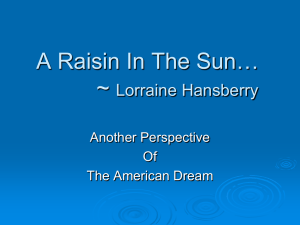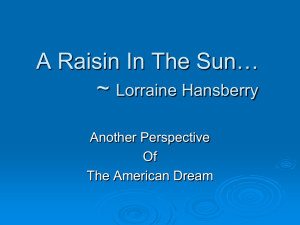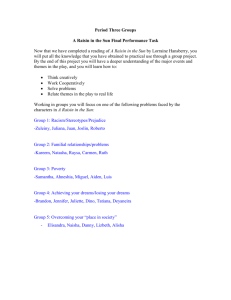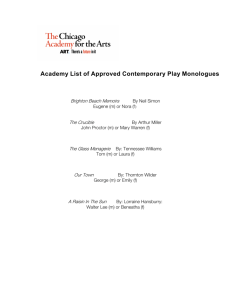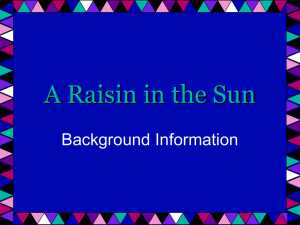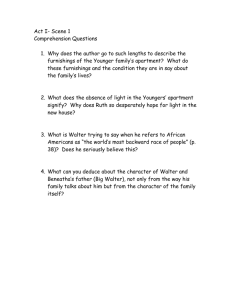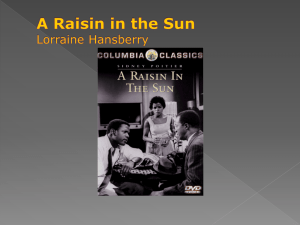A Raisin in the Sun
advertisement
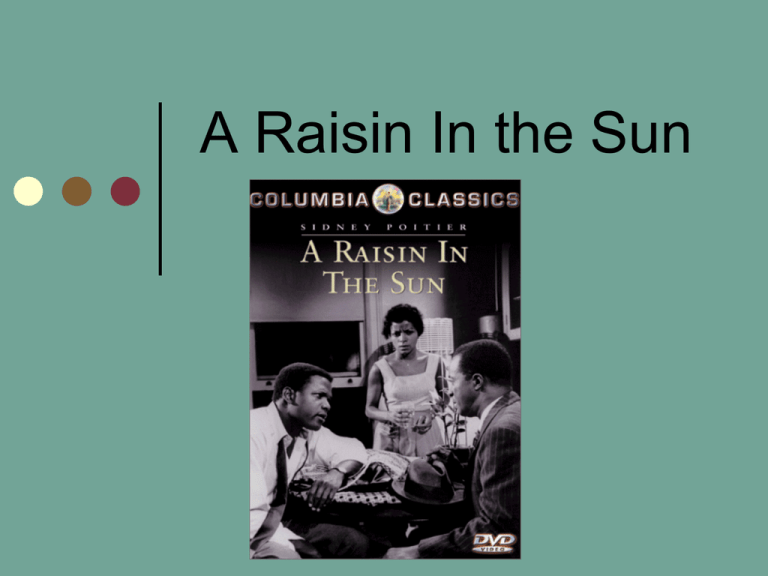
A Raisin In the Sun Social Background Published in 1959, four years after Rosa Parks’ was arrested for refusing to give up her seat to a white person on a bus, sparking the Civil Rights Movement, Hansberry’s play illustrates black America’s struggle to gain equal access to opportunity and expression of cultural identity. Sentiments in A Raisin… will be echoed by MLK in later speeches, marches, and rallies Martin Luther King, Jr. Civil-Rights Leader 1929-1968 I have a dream… a dream deeply rooted in the American dream. I have a dream that one day this nation will rise up and live out the true meaning of its creed: ‘We hold these truths to be self-evident: that all men are created equal.’ Cont’d dreams represented in the play and later echoed by King I have a dream that my four children will one day live in a nation where they will not be judged by the color of their skin but by the content of their character. I have a dream…where little black boys and black girls will be able to join hands with little white boys and white girls and walk together as sisters and brothers. In 1956, King leads a boycott of the bus laws. In 1954, the Supreme Court found in favor of the plaintiffs in the Brown v. The Board of Education case. However, the segregation of schools didn’t begin to take effect until 1957. Moreover, the case’s decision did not abolish segregation in other public areas, such as restaurants and restrooms. Integration and Segregation in the United States: Chronology 1861-65 Civil War years. 1866 Ku Klux Klan established in Tennessee. 1870 Passage of Fifteenth Amendment to U.S. Constitution prohibiting racial discrimination in voting. 1882 Chinese Exclusionary Act banning Chinese immigration to the United States for ten years. 1896 Plessy v. Ferguson Supreme Court decision permitting "separate but equal” public racial facilities. 1907 Supreme Court declares that railroads have the right to segregate passengers. 1909 National Association for the Advancement of Colored People (NAACP) founded. 1911 National Urban League founded. 1919 Race riots in Chicago. 1924 Immigration Act establishing quotas based on national origin. Integration and Segregation in the United States: 1927 Urban League organizes boycott of stores refusing to hire blacks 1943 Race riots in Detroit. 1946 Supreme Court declares that segregation on buses is unconstitutional. 1947 Jackie Robinson becomes first African American to play major league baseball. 1948 President Truman issues executive order integrating armed forces. 1949 Supreme Court rules that local "covenants" enforcing segregated neighborhoods are unconstitutional. National Housing Act addressing substandard housing. 1954 Brown v. Board of Education Supreme Court ruling that "separate but equal“ doctrine regarding school segregation is unconstitutional. 1955 Bus boycott in Montgomery, Alabama. 1957 School desegregation crisis in Little Rock, Arkansas. 1960 "Sit-ins" begin at Woolworth's in Greensboro, North Carolina. 1961 "Freedom Riders" attempt to force integration in Alabama. 1962 African American student James Meridith is denied admission to the University of Mississippi, resulting in contempt charges against the governor of Mississippi. 1963 George Wallace's "school house stand" attempting to block integration of theUniversity of Alabama. Martin Luther King Jr. arrested in Birmingham, Alabama, while leading civil rights demonstrations. March on Washington, D.C., demonstrating for civil rights. 1964 Martin Luther King, Jr. wins the Nobel Peace Prize. Race riots in Harlem. 1965 Malcolm X assassinated. Martin Luther King Jr. leads march from Selma to Montgomery, Alabama. Race riots in Watts, Los Angeles. Immigration law abolishes quota system. Voting Rights Bill passed. 1967 Black Power conference held in Newark, New Jersey. Race riots in Cleveland, Newark, and Detroit. 1968 Civil Rights Act of 1968 guaranteeing fair treatment in housing. Martin Luther King Jr. assasinated. World of the 1950s • Population: 151,684,000 (U.S. Dept. of Commerce, Bureau of the Census) • Unemployed: 3,288,000 • Life expectancy: Women 71.1, men 65.6 • Car Sales: 6,665,800 • Average Salary: $2,992 • Labor Force male/female: 5/2 • Cost of a loaf of bread: $0.14 • Bomb shelter plans, like the government pamphlet You Can Survive, become widely available Hansberry’s Background 1930-1965 A Raisin…is the 1st play by a black woman to be produced on Broadway Other Works: WHAT USE ARE FLOWERS? THE MOVEMENT: DOCUMENTARY OF A STRUGGLE FOR EQUALITY, THE SIGN IN SIDNEY BRUSTEIN' WINDOWTO BE YOUNG, GIFTED, AND BLACK: LES BLANCS: THE COLLECTED LAST PLAYS: The Drinking Gourd / What Use Are Flowers? A Note on the Title Lorraine Hansberry took the title of A Raisin in the Sun from a line in Langston Hughes’s famous 1951 poem “Harlem.” “Harlem” captures the tension between the need for black expression and the impossibility of that expression because of American society’s oppression of its black population. In the poem, Hughes asks whether a “dream deferred”—a dream put on hold—withers up “like a raisin in the sun.” More on the title His lines confront the racist and dehumanizing attitude prevalent in American society before the civil rights movement of the 1960s. Hansberry’s reference to Hughes’s poem in her play’s title highlights the importance of dreams in A Raisin in the Sun and the struggle that her characters face to realize their individual dreams, a struggle tied to the more fundamental black dream of equality in America. The novel A Raisin in the Sun can be considered a turning point in American art because it addresses so many issues important during the 1950s in the United States. The stereotype of 1950s America as a land of happy housewives and blacks content with their inferior status resulted in an uprising of social resentment that would finally find public voice in the civil rights and feminist movements of the 1960s. Character List Walter Lee Younger - The protagonist of the play. He wants to be rich; wants to invest his father’s insurance money in a new liquor store venture. Lena Younger (“Mama”) religious, moral, and maternal. She wants to use her husband’s insurance money as a down payment on a house with a backyard to fulfill her dream for her family to move up in the world. More characters Beneatha Younger (“Bennie”) Beneatha is twenty years old, she attends college, and is better educated than the rest of the Younger family. She dreams of being a doctor and struggles to determine her identity as a well-educated black woman. Ruth Younger Walter’s wife and Travis’s mother. Ruth takes care of the Youngers’ small apartment. She is about thirty, but her weariness makes her seem older. Characters cont. Travis Younger - Walter and Ruth’s sheltered young son. Travis earns some money by carrying grocery bags and likes to play outside with other neighborhood children, but he has no bedroom and sleeps on the living-room sofa. Joseph Asagai - A Nigerian student in love with Beneatha. Asagai, as he is often called, is very proud of his African heritage, and Beneatha hopes to learn about her African heritage from him. Even more characters George Murchison - A wealthy, AfricanAmerican man who dates Beneatha. The Youngers approve of George, but Beneatha dislikes his willingness to submit to white culture and forget his African heritage. Mr. Karl Lindner - The only white character in the play. He offers the Youngers a deal to reconsider moving into his (all-white) neighborhood. Mrs. Johnson - The Youngers’ neighbor; warns them about moving into a predominately white neighborhood. Themes A Raisin in the Sun is essentially about dreams, as the main characters struggle to deal with the oppressive circumstances that rule their lives. Every member of the Younger family has a separate, individual dream—Beneatha wants to become a doctor, for example, and Walter wants to have money so that he can afford things for his family. The Youngers struggle to attain these dreams throughout the play, and much of their happiness and depression is directly related to their attainment of, or failure to attain, these dreams. The Need to Fight Racial Discrimination The character of Mr. Lindner makes the theme of racial discrimination prominent in the plot as an issue that the Youngers cannot avoid. Mr. Lindner and the people he represents can only see the color of the Younger family’s skin, Ultimately, the Youngers respond to this discrimination with defiance and strength. Restrictive Covenants In the 1948 Shelley v. Kraemer decision, the United States Supreme Court found the use of racially restrictive covenants illegal. They were clauses in deeds for real estate sales that were created to preserve the architectural or social homogeneity of a neighborhood. Restrictive covenants could limit anything from hanging laundry outside to the sale or rental of homes to nonwhites. Restrictive Covenants Continued In 1941, a half-mile-long concrete wall was erected to separate an AfricanAmerican neighborhood in Detroit from the white section. In that city, by 1947 over 80 percent of property outside of the inner city had racially restrictive stipulations. The Importance of Family The Youngers struggle socially and economically throughout the play but unite in the end to realize their dream of buying a house. Mama strongly believes in the importance of family, and she tries to teach this value to her family as she struggles to keep them together and functioning. Walter and Beneatha learn this lesson about family at the end of the play. Setting: The Home The Younger apartment is the only setting throughout the play, emphasizing the centrality of the home. The home is a galvanizing force for the family, one that Mama sees as crucial to the family’s unity. The play ends, fittingly, when Mama, lagging behind, finally leaves the apartment. Crowded Quarters The housing crunch in Northern cities, along with the segregation and discrimination facing African Americans attempting to find places to live, led to extremely crowded conditions, such as those pictured in this Chicago residence in 1941. Symbols “Eat Your Eggs” Being quiet and eating one’s eggs represents an acceptance of the adversity that Walter and the rest of the Youngers face in life. Walter believes that Ruth, who is making his eggs, keeps him from achieving his dream, and he argues that she should be more supportive of him. The eggs she makes every day symbolize her mechanical approach to supporting him. She provides him with nourishment, but always in the same, predictable way. Mama’s Plant The most overt symbol in the play, Mama’s plant represents both Mama’s care and her dream for her family. The plant also symbolizes her dream to own a house and, more specifically, to have a garden and a yard Beneatha’s Hair When the play begins, Beneatha has straightened hair. Midway through the play, after Asagai visits her and questions her hairstyle, she cuts her Caucasian-seeming hair. Her new, radical afro represents her embracing of her heritage. This prefigures the 1960s cultural credo that black is beautiful. Journal Describe a dream or goal that you have. Discuss what obstacles might stand in your way? What are you willing to sacrifice in order to obtain this goal?
